Brioche
This post may contain affiliate links. Read my full disclosure policy.
Adapted from Artisan Bread in 5 Minutes A Day, this fluffy brioche is easy to make at home.
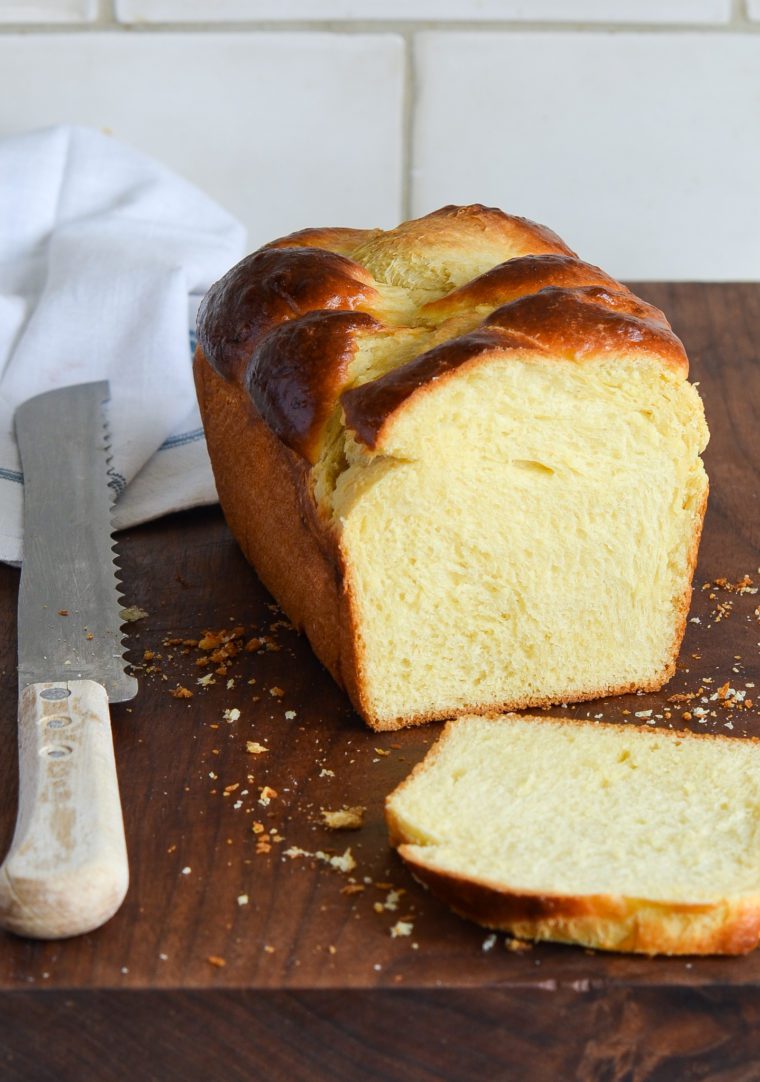
Brioche is a French bread with a fluffy interior, slightly sweet flavor, and shiny golden crust. It’s made from an enriched dough, meaning it includes ingredients beyond the basic flour, salt, water, and yeast used to make white or artisan bread. These extra ingredients, like butter, eggs and sugar, give brioche a deliciously rich flavor—similar to challah, only richer.
This easy brioche recipe is modestly adapted from Artisan Bread in 5 Minutes A Day by Jeff Hertzberg M.D. and Zoë François. The dough takes just minutes to make and only needs to be kneaded by hand for 30 seconds. The hardest part is waiting for it rise: it requires a 2-hour rise at room temperature after mixing followed by at least 3 hours in the fridge, and then another 1½ hours after it’s braided and placed in the loaf pan. Since the recipe makes two loaves, you can give one away or freeze one for later. If you happen to have some left over, stale brioche makes wonderful stand in in my challah French toast or bread pudding. Brioche dough is also a great base for babka and sticky buns.
What You’ll Need to Make Brioche
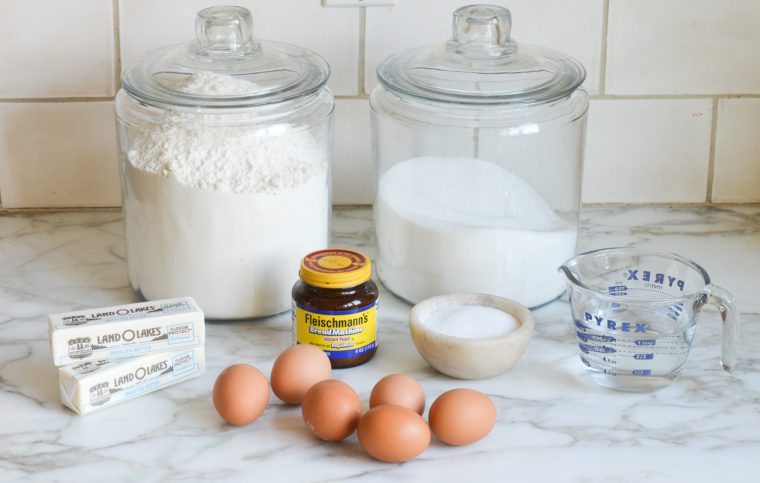
Step-by-Step Instructions
In a large bowl, combine the melted butter, warm water, sugar, salt and yeast.
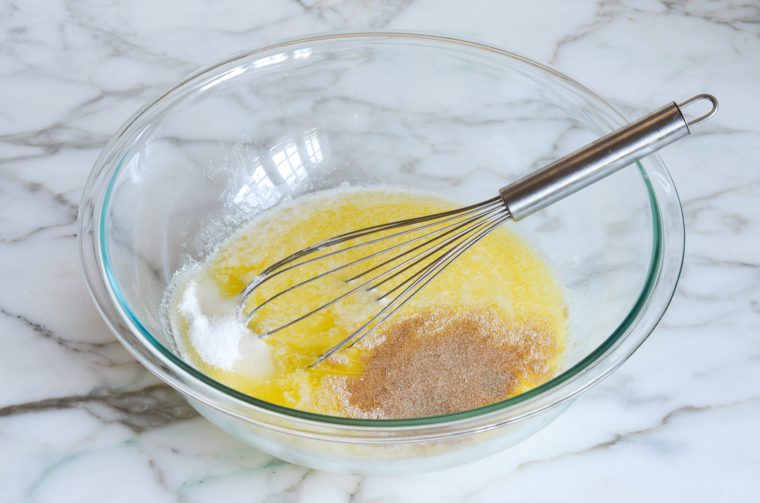
Whisk to combine, and then add 5 of the eggs.
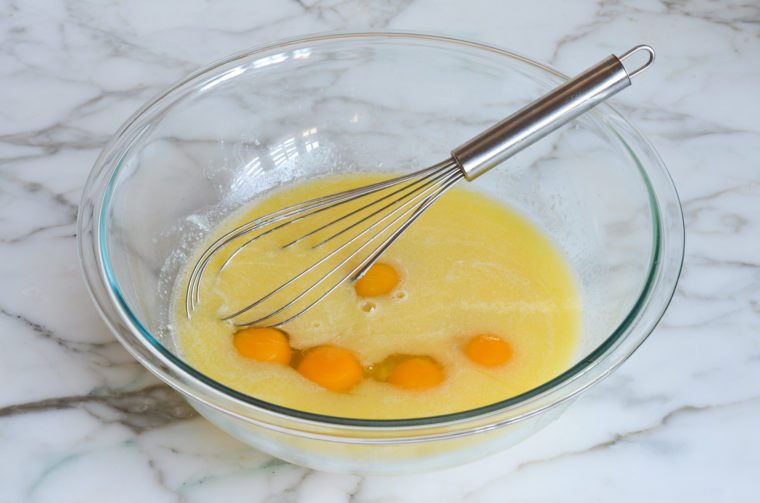
Whisk again until evenly combined.
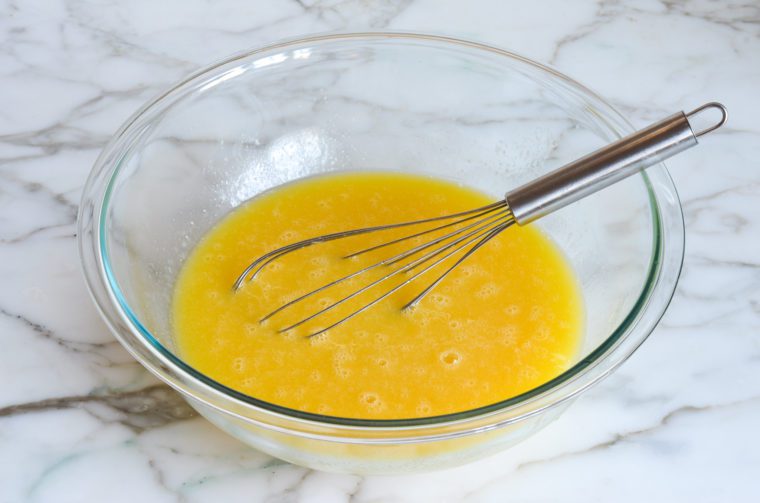
Add the flour all at once.
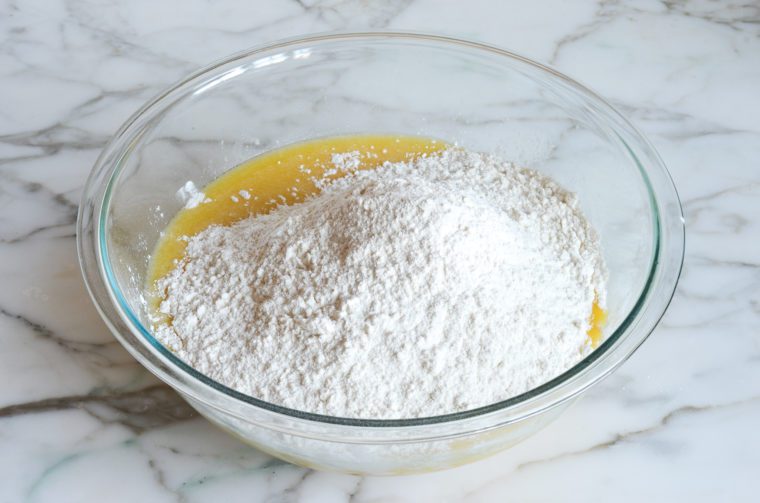
Stir with a wooden spoon until the mixture is uniform.
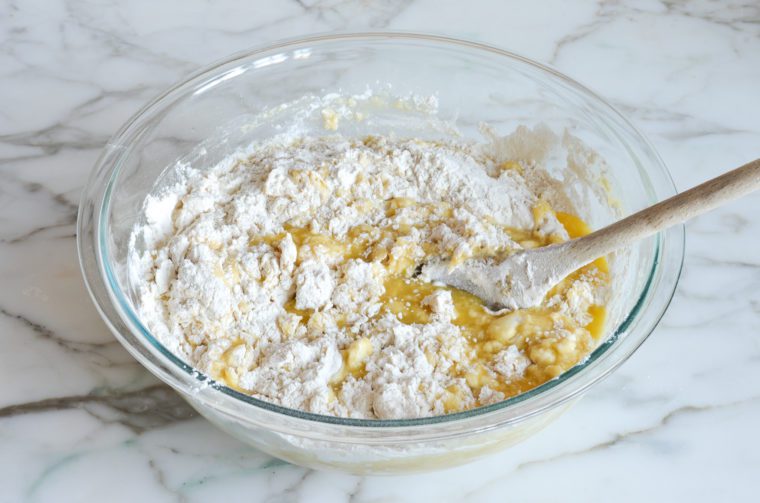
The dough will be wet, lumpy, and a bit elastic (it will firm up in the fridge and smooth out when you knead it). 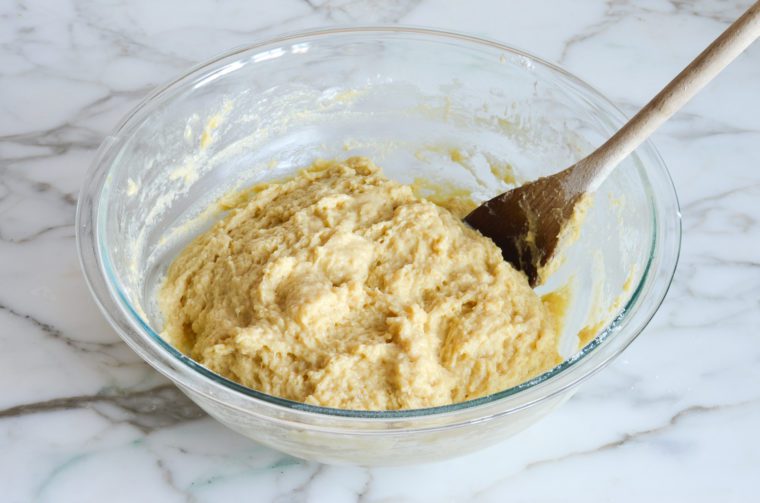
Cover loosely with plastic wrap (make sure the entire bowl is covered but don’t seal it airtight) and let sit at room temperature for 2 hours, then refrigerate for at least 3 hours or up to three days.
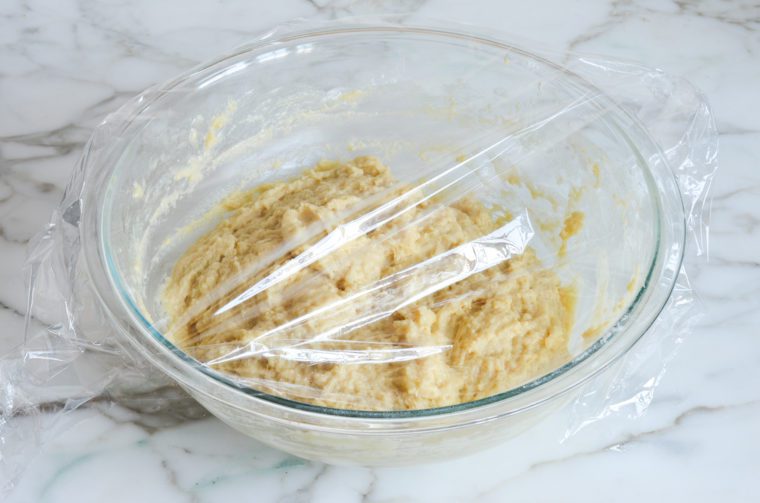
On the day of baking, grease an 8½ x 4½-inch loaf pan with butter (or two loaf pans if you’re baking both loaves at the same time). Dust a clean work surface generously with flour. Dust the dough in the bowl with flour and use a knife to cut it in half.
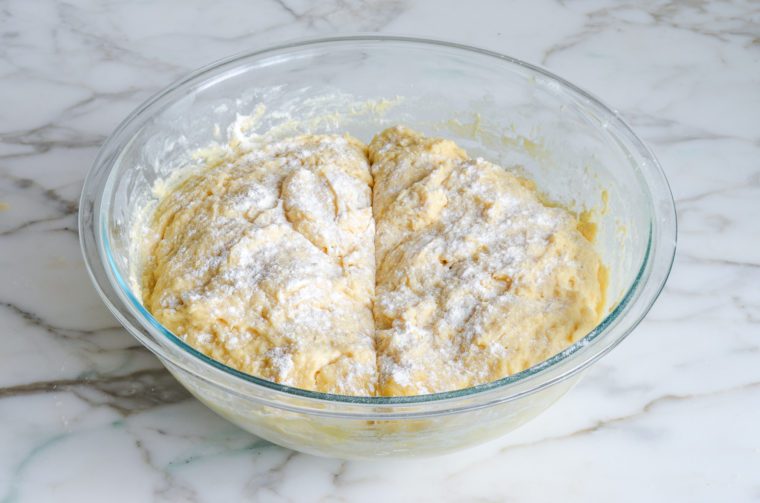
Pull out half of the dough and place on the floured work surface; cover the remaining half with plastic wrap (not airtight) and place back in the refrigerator until ready to bake. (The dough can be used anytime within the 3 day window, or frozen in an airtight container for up to two weeks. When ready to use the frozen dough, thaw in the refrigerator for 24 hours before using, then continue with the next step.)
Dust the dough with more flour and knead, sprinkling more flour as necessary so the dough doesn’t stick, for about 30 seconds.
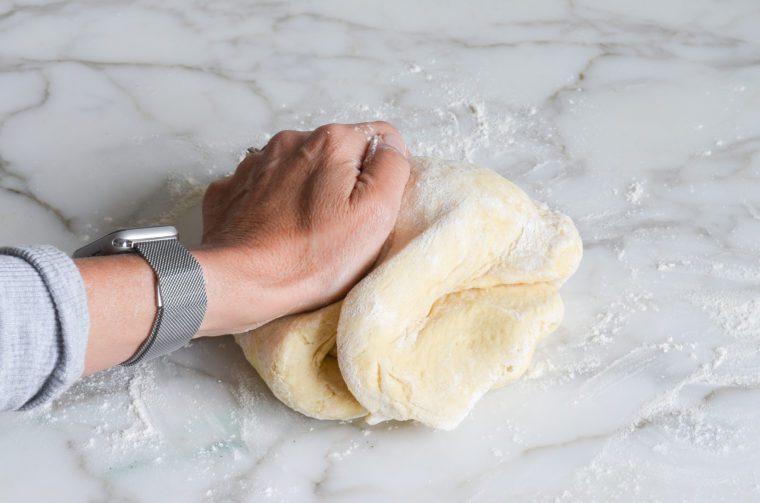
Divide the dough into 3 equal portions (about 9 oz each). 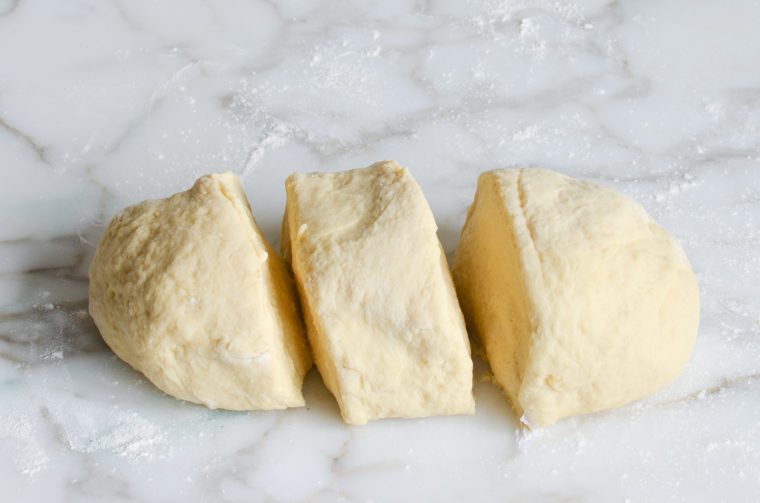
Using your hands, roll each one into a 13-inch strand.
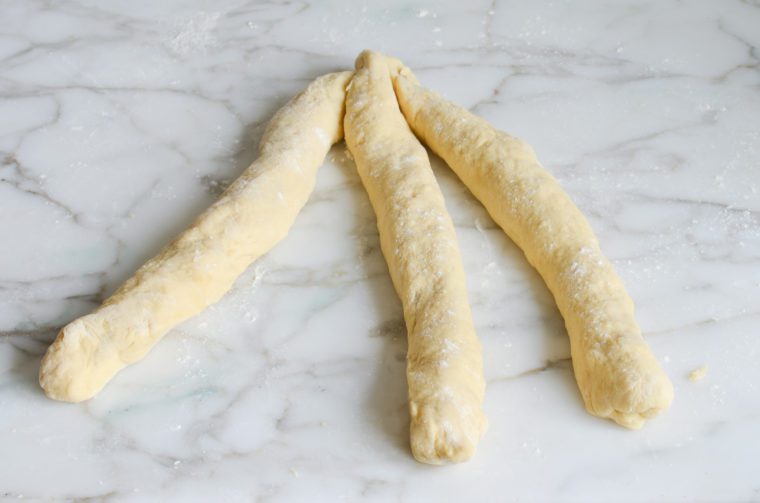
Pinch the three strands together at the top and braid.
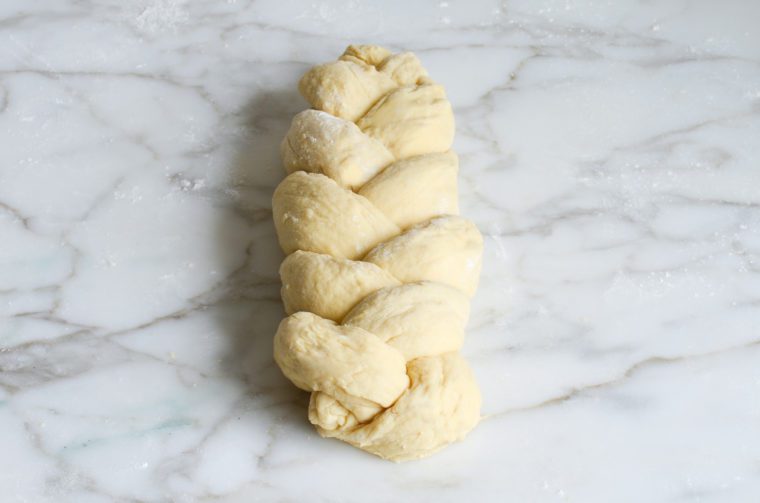
Place the braided dough into the prepared loaf pan, tucking the ends underneath. (Alternatively, if you don’t want to braid the dough, simply elongate it into an oval and place in the prepared pan.) Cover loosely with plastic wrap (not airtight) and let sit at room temperature for 90 minutes.
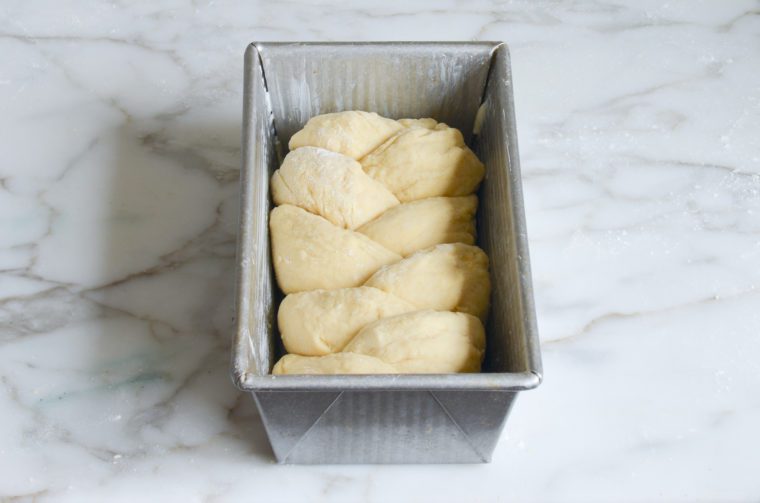
Preheat the oven to 350°F and set an oven rack in the middle position. Beat the remaining egg in a small bowl and brush it evenly onto the dough.
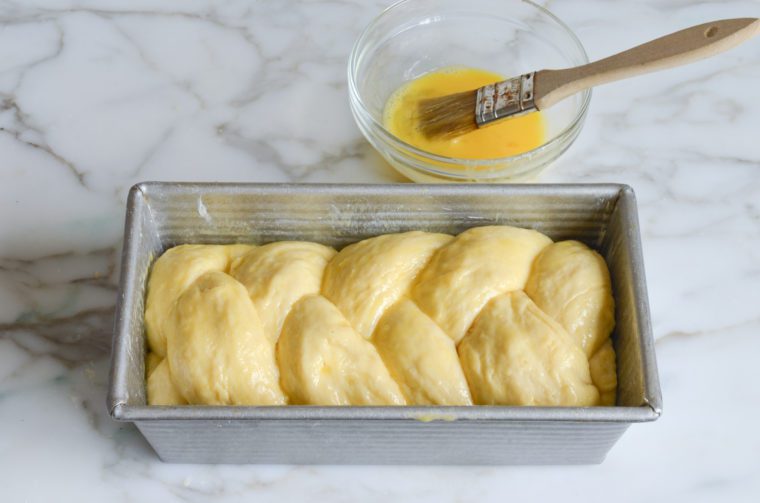
Bake for 45 to 50 minutes, until the bread is a rich golden brown color. Let cool in the pan on a rack for 15 minutes. 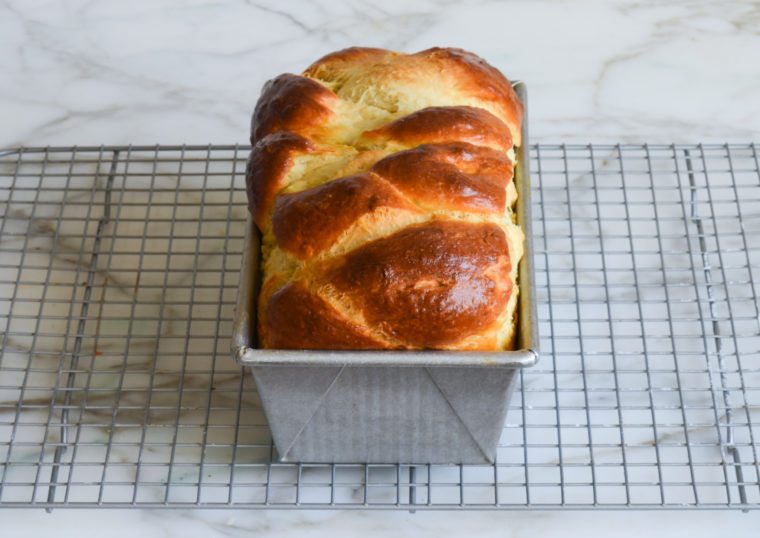
Turn the loaf out of the pan and let cool completely before slicing.
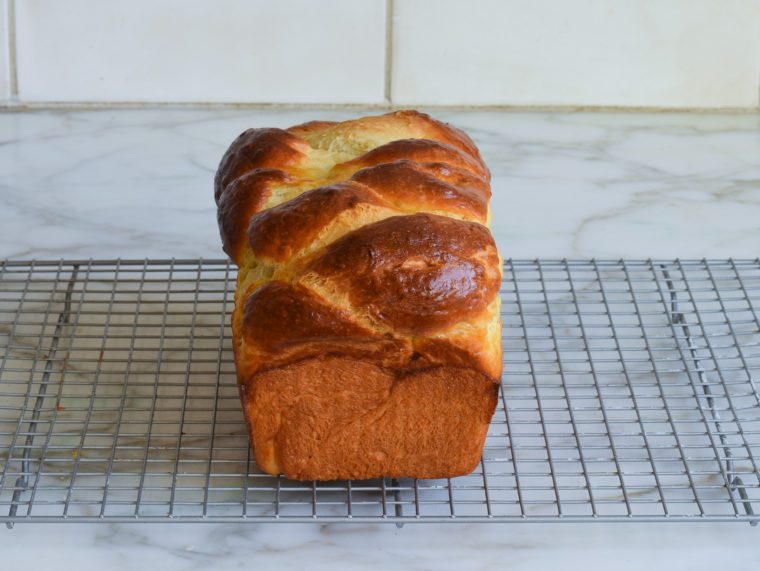
How to Freeze Brioche
Brioche is best enjoyed fresh on the day it is made, but it freezes well too. Wrap your cooled brioche loaf in aluminum foil and place in a freezer bag, pushing out as much air as possible, and seal tightly. Freeze for up to 2 months. When ready to serve the bread, take it out and let it thaw at room temperature. If you don’t plan to serve the whole loaf at once, you might consider slicing the bread or portioning it into a few larger pieces before freezing (defrosting and re-freezing will cause the bread to deteriorate).

You may also like
Brioche
Adapted from Artisan Bread in 5 Minutes A Day, this fluffy brioche is easy to make at home.
Ingredients
- 2 sticks (1 cup) unsalted butter, melted and slightly cooled, plus more for greasing the pans
- 1 cup warm water (see note)
- ½ cup sugar
- 2¼ teaspoons salt
- 2 teaspoons instant/rapid-rise yeast
- 6 large eggs, divided (5 for dough and 1 for egg wash)
- 5½ cups all-purpose flour, spooned into measuring cup and leveled off, plus more for kneading and braiding
Instructions
- In a large bowl, whisk together the melted butter, warm water, sugar, salt and yeast. Add 5 of the eggs and whisk until evenly combined. Add the flour all at once and stir with a wooden spoon until the mixture is uniform; it will be wet, lumpy, and a bit elastic (it will firm up in the fridge and smooth out when you knead it). Cover loosely with plastic wrap (make sure the entire bowl is covered but don't seal it airtight) and let sit at room temperature for 2 hours, then refrigerate for at least 3 hours or up to three days.
- On the day of baking, grease an 8½ x 4½-inch loaf pan with butter (or two loaf pans if you're baking both loaves at the same time). Dust a clean work surface generously with flour. Dust the dough in the bowl with flour and use a knife to cut it in half. Pull out half of the dough and place it on the floured work surface; cover the remaining half with plastic wrap (not airtight) and place it back in the refrigerator until ready to bake. (The dough can be used anytime within the 3 day window, or frozen in an airtight container for up to two weeks. When ready to use the frozen dough, thaw in the refrigerator for 24 hours before using, then continue with the next step.)
- Dust the dough with more flour and knead, sprinkling more flour as necessary so the dough doesn't stick, for about 30 seconds. Divide the dough into 3 equal portions (about 9 oz each) and, using your hands, roll each one into a 13-inch strand. Pinch the three strands together at the top and braid. Place the braided dough into the prepared loaf pan, tucking the ends underneath. (Alternatively, if you don't want to braid the dough, simply elongate it into an oval and place in the prepared pan.) Cover the pan loosely with plastic wrap (not airtight) and let sit at room temperature for 90 minutes. (It will rise just a bit.)
- Preheat the oven to 350°F and set an oven rack in the middle position.
- Beat the remaining egg in a small bowl. Brush it evenly onto the dough (cover and refrigerate the remaining egg wash for the second loaf, or discard if not using within 2 days). Bake for 45 to 50 minutes, until the bread is a rich golden brown color. Let cool in the pan on a rack for 15 minutes, then turn out and let cool completely before slicing.
- Note: Warm water helps activate the yeast. The temperature should be about 110°F, but it doesn't need to be exact so no need to use a thermometer; just try to get it about the temperature of bath water.
- Note: If you'd like to bake both loaves at the same time, allow a few extra minutes baking time.
- Make-Ahead/Freezing Instructions: Brioche is best served fresh the day it is baked, but it will keep in a plastic bag or wrapped in foil at room temperature for a few days. The bread can also be frozen for up to 2 months. To freeze, wrap the cooled brioche loaf in aluminum foil and place in a freezer bag, pushing out as much air as possible, and seal tightly. When ready to serve the bread, take it out and let it thaw at room temperature. If you don’t plan to serve the whole loaf at once, slice the bread or portion it into a few larger pieces before freezing (defrosting and re-freezing will cause the bread to deteriorate).
Nutrition Information
Powered by ![]()
- Per serving (20 servings)
- Serving size: 1 slice
- Calories: 248
- Fat: 11 g
- Saturated fat: 6 g
- Carbohydrates: 32 g
- Sugar: 5 g
- Fiber: 1 g
- Protein: 6 g
- Sodium: 154 mg
- Cholesterol: 80 mg
This website is written and produced for informational purposes only. I am not a certified nutritionist and the nutritional data on this site has not been evaluated or approved by a nutritionist or the Food and Drug Administration. Nutritional information is offered as a courtesy and should not be construed as a guarantee. The data is calculated through an online nutritional calculator, Edamam.com. Although I do my best to provide accurate nutritional information, these figures should be considered estimates only. Varying factors such as product types or brands purchased, natural fluctuations in fresh produce, and the way ingredients are processed change the effective nutritional information in any given recipe. Furthermore, different online calculators provide different results depending on their own nutrition fact sources and algorithms. To obtain the most accurate nutritional information in a given recipe, you should calculate the nutritional information with the actual ingredients used in your recipe, using your preferred nutrition calculator.

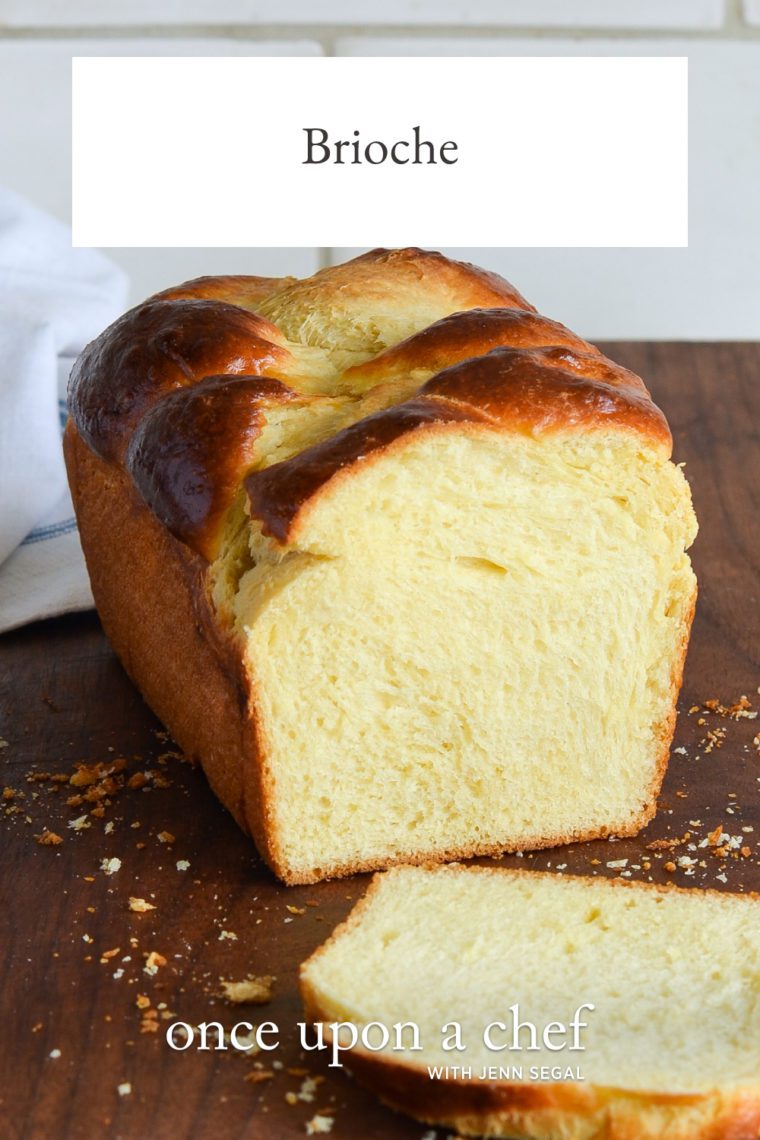
This bread was easy and delicious. But you might want to let your readers know that it does not rise significantly before it is baked the way other breads do; I almost tossed the dough before baking because it looked like a failure. I decided to bake it anyway, and that is when the real rising occurred. So glad I did!
Done! So glad you enjoyed it. 🙂
I made this bread today, can’t wait to taste it. The only problem seems to be that the braids seem to separate quite a bit. Is there any way to keep that from happening? Other that that, they came out fantastic. I think that next time I will use a 9×5 inch loaf pan though because they had quite a bit of oven spring. The sides on my 9″x5″ loaf pans are a little higher so that may help support the over spring. What do you think?
Hi Greg, regarding the braids, do you mean that they separated while you were trying to braid the dough or while they were baking? Regardless, do you do by any chance have a picture of it? If so, feel free to email me at jennifer@onceuponachef.com. And regarding the loaf pan, make sure you’re using an 8 1/2 x 4 1/2“ loaf pan not an 8 x 4“. And what you’ve described regarding the bread springing out of the pan is just the nature of brioche, but if you’d prefer to use a 9 x 5“ loaf pan, that should be fine. Hope it came out well!
Hello Jen. Can the recipe be halved to make one loaf? I know there is precision with baking, so I wanted your thoughts before proceeding. Thank you!
Hi Donna, It’s perfectly fine to halve the recipe. For the eggs in the dough, use 2 whole eggs and 1 egg yolk. 🙂
Hey Jenn, once again I’m looking forward to trying another one of your recipes. I’ve been dying to try and make this but most recipes seem so complicated and yours doesn’t. My only question is regarding the warm water. What temperature should it be at or does it matter? I ask because usually when you’re making basic bread (for lack of a better term), the milk is usually at a temp of 100-110 degrees F for the yeast. Is it the same for this? Thanks!
Hi Judy, It doesn’t have to be exact (I never check it), but yes that’s correct. I will update the recipe to include that. Hope you enjoy! 🙂
Can you make this with gluten free bread flour and have the same results? Thanks, Jenn! I love your recipes. You are my go-to chef!!
Hi Beth, So happy you enjoy the recipes! I think the gluten-free flour will work, but it won’t be the same in terms of texture or flavor (not bad, just different!).
Hi Jenn!
This looks delicious and easy! In the ingredients list, it says “5½ cups grams all-purpose flour” – I’m guessing it’s 5 1/2 cups and the word “grams” is just a typo, but I wanted to make sure. Thanks!
Yes, a typo – thank you for letting me know. It’s fixed!
Could this be made into rolls instead of a loaf, what shape may be best for making rolls and what would estimated baking time be?
Sure, Stefanie. You can shape the dough into 16 or so balls and place in two greased 9-inch cake pans (or equivalent baking dishes), let rise for about 60 minutes, then bake at 350°F for 25 to 30 minutes. I’d love to know how they turn out if you try it!
Hi Jenn. If I used milk instead of water for the brioche, do you think the loaf would be delicious? Thank you so much for this recipe.
Definitely!
Hi Jen, I have a pullman loaf covered pan measuring 13 inches long, 4 1/2 inches wide, and 4 inches deep….do you think the recipe would work for this ?
Thanks for any advice!
Hi Gayann, I would increase the recipe by a third and then divide into two long loaves. Or you could use 2/3 of the dough to make 1 long loaf, and the remaining third could be used to make a few smaller rolls (roll the dough into balls and place in a small pan, like you would dinner rolls, or bake the dough balls in a muffin tin). Hope that helps and please LMK how it turns out if you try it.
In my haste to load my car for our trip to NC for the summer, I forgot my pullman pan, but will make the bread today in two pans, as directed! Will save your suggestion for when I return to Florida! Thanks as always!
I can’t wait to make this! Do you use fine sea salt or Diamond Crystal Kosher salt? Thanks!
Hi Sally, I use fine sea salt in all my recipes unless otherwise specified. 🙂
Jenn,
What’s your favorite way to serve this bread ? Is it best just buttered w/dinner ?
Candy
Hi Candace, It’s wonderful with dinner, as a sandwich bread, or toasted and topped with butter and jam for breakfast.